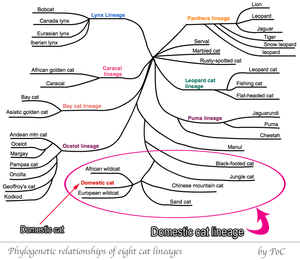Cat Breed Evolution: Difference between revisions
| Line 2: | Line 2: | ||
The evolution of domestic cat breeds is a long and interesting tale that started in 7500 BC in what was then called the Near East. These cats began their descent into the common domestic cat around 4400 BC when they began a mutually beneficial relationship with the earliest farmers.<ref>[https://www.nationalgeographic.com/science/article/domesticated-cats-dna-genetics-pets-science. Smith, Casey. “Cats Domesticated Themselves, Ancient DNA Shows.” Science. National Geographic, May 3, 2021.]</ref> In return for helping control rodent populations and providing company, these animals got food and protection from the elements. Different breeds began to appear when artificial selection led to the wide range in size, color, and behavior shown in modern day cats, whose Latin name is <i>Felis catus</i>. | The evolution of domestic cat breeds is a long and interesting tale that started in 7500 BC in what was then called the Near East. These cats began their descent into the common domestic cat around 4400 BC when they began a mutually beneficial relationship with the earliest farmers.<ref>[https://www.nationalgeographic.com/science/article/domesticated-cats-dna-genetics-pets-science. Smith, Casey. “Cats Domesticated Themselves, Ancient DNA Shows.” Science. National Geographic, May 3, 2021.]</ref> In return for helping control rodent populations and providing company, these animals got food and protection from the elements. Different breeds began to appear when artificial selection led to the wide range in size, color, and behavior shown in modern day cats, whose Latin name is <i>Felis catus</i>. | ||
There are many different ideas on how cats evolved to become domesticated like they are today. The most prevalent idea is that cats were able to board shipping line ships and travel around the world starting in 2000 BCE. These cats stayed by the human’s side as feral pets, but were never fully controlled. They still hunted for their own food and bred how they wanted. This great migration of cats began in Western Asia and spread to Western Europe, the Mediterranean, and Africa. | There are many different ideas on how cats evolved to become domesticated like they are today. The most prevalent idea is that cats were able to board shipping line ships and travel around the world starting in 2000 BCE.<ref>[https://www.loc.gov/everyday-mysteries/item/how-did-cats-become-domesticated/. “How Did Cats Become Domesticated?” The Library of Congress. Accessed December 8, 2021.]</ref> These cats stayed by the human’s side as feral pets, but were never fully controlled. They still hunted for their own food and bred how they wanted. This great migration of cats began in Western Asia and spread to Western Europe, the Mediterranean, and Africa. | ||
Over time, around 1700 BCE, the demand for Egyptian cats increased 10 fold because of their beautiful fur and friendly dispositions. This led to a “cat trading ban” around 1500 BCE but by that time, cats had infiltrated most homes, hunting parties, and cities. | Over time, around 1700 BCE, the demand for Egyptian cats increased 10 fold because of their beautiful fur and friendly dispositions. This led to a “cat trading ban” around 1500 BCE but by that time, cats had infiltrated most homes, hunting parties, and cities. | ||
Revision as of 13:37, 8 December 2021
Introduction
The evolution of domestic cat breeds is a long and interesting tale that started in 7500 BC in what was then called the Near East. These cats began their descent into the common domestic cat around 4400 BC when they began a mutually beneficial relationship with the earliest farmers.[1] In return for helping control rodent populations and providing company, these animals got food and protection from the elements. Different breeds began to appear when artificial selection led to the wide range in size, color, and behavior shown in modern day cats, whose Latin name is Felis catus.
There are many different ideas on how cats evolved to become domesticated like they are today. The most prevalent idea is that cats were able to board shipping line ships and travel around the world starting in 2000 BCE.[2] These cats stayed by the human’s side as feral pets, but were never fully controlled. They still hunted for their own food and bred how they wanted. This great migration of cats began in Western Asia and spread to Western Europe, the Mediterranean, and Africa.
Over time, around 1700 BCE, the demand for Egyptian cats increased 10 fold because of their beautiful fur and friendly dispositions. This led to a “cat trading ban” around 1500 BCE but by that time, cats had infiltrated most homes, hunting parties, and cities.

Section 1 Genetics
Include some current research, with at least one image.
Sample citations: [3]
[4]
A citation code consists of a hyperlinked reference within "ref" begin and end codes.
Section 2 Microbiome
Include some current research, with a second image.
Conclusion
Overall text length (all text sections) should be at least 1,000 words (before counting references), with at least 2 images.
Include at least 5 references under References section.
References
- ↑ Smith, Casey. “Cats Domesticated Themselves, Ancient DNA Shows.” Science. National Geographic, May 3, 2021.
- ↑ “How Did Cats Become Domesticated?” The Library of Congress. Accessed December 8, 2021.
- ↑ Hodgkin, J. and Partridge, F.A. "Caenorhabditis elegans meets microsporidia: the nematode killers from Paris." 2008. PLoS Biology 6:2634-2637.
- ↑ Bartlett et al.: Oncolytic viruses as therapeutic cancer vaccines. Molecular Cancer 2013 12:103.
- ↑ Lee G, Low RI, Amsterdam EA, Demaria AN, Huber PW, Mason DT. Hemodynamic effects of morphine and nalbuphine in acute myocardial infarction. Clinical Pharmacology & Therapeutics. 1981 May;29(5):576-81.
Edited by Katianna Blackwell-Scott, student of Joan Slonczewski for BIOL 116 Information in Living Systems, 2021, Kenyon College.
